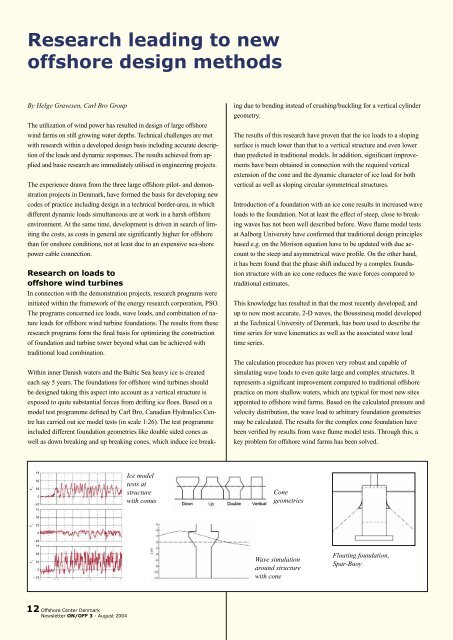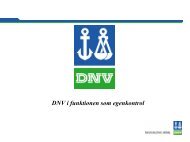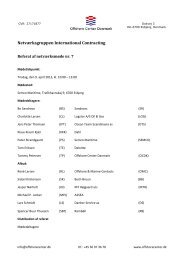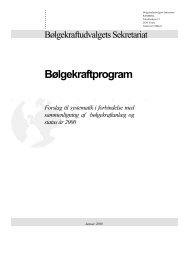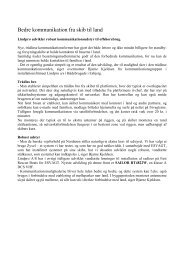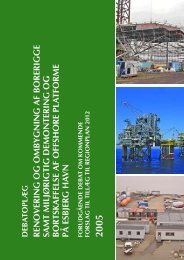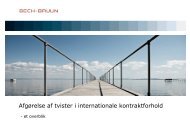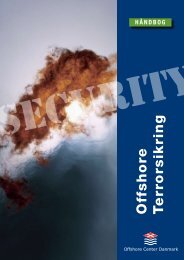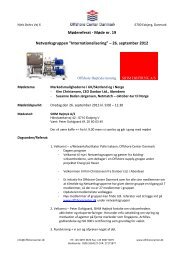Read News Magazine (pdf) - Offshore Center Danmark
Read News Magazine (pdf) - Offshore Center Danmark
Read News Magazine (pdf) - Offshore Center Danmark
You also want an ePaper? Increase the reach of your titles
YUMPU automatically turns print PDFs into web optimized ePapers that Google loves.
Research leading to new<br />
offshore design methods<br />
By Helge Gravesen, Carl Bro Group<br />
The utilization of wind power has resulted in design of large offshore<br />
wind farms on still growing water depths. Technical challenges are met<br />
with research within a developed design basis including accurate description<br />
of the loads and dynamic responses. The results achieved from applied<br />
and basic research are immediately utilised in engineering projects.<br />
The experience drawn from the three large offshore pilot- and demonstration<br />
projects in Denmark, have formed the basis for developing new<br />
codes of practice including design in a technical border-area, in which<br />
different dynamic loads simultaneous are at work in a harsh offshore<br />
environment. At the same time, development is driven in search of limiting<br />
the costs, as costs in general are significantly higher for offshore<br />
than for onshore conditions, not at least due to an expensive sea-shore<br />
power cable connection.<br />
Research on loads to<br />
offshore wind turbines<br />
In connection with the demonstration projects, research programs were<br />
initiated within the framework of the energy research corporation, PSO.<br />
The programs concerned ice loads, wave loads, and combination of nature<br />
loads for offshore wind turbine foundations. The results from these<br />
research programs form the final basis for optimizing the construction<br />
of foundation and turbine tower beyond what can be achieved with<br />
traditional load combination.<br />
Within inner Danish waters and the Baltic Sea heavy ice is created<br />
each say 5 years. The foundations for offshore wind turbines should<br />
be designed taking this aspect into account as a vertical structure is<br />
exposed to quite substantial forces from drifting ice floes. Based on a<br />
model test programme defined by Carl Bro, Canadian Hydraulics Centre<br />
has carried out ice model tests (in scale 1:26). The test programme<br />
included different foundation geometries like double sided cones as<br />
well as down breaking and up breaking cones, which induce ice break-<br />
12 <strong>Offshore</strong> <strong>Center</strong> Denmark<br />
<strong>News</strong>letter ON/OFF 3 - August 2004<br />
Ice model<br />
tests at<br />
structure<br />
with conus<br />
ing due to bending instead of crushing/buckling for a vertical cylinder<br />
geometry.<br />
The results of this research have proven that the ice loads to a sloping<br />
surface is much lower than that to a vertical structure and even lower<br />
than predicted in traditional models. In addition, significant improvements<br />
have been obtained in connection with the required vertical<br />
extension of the cone and the dynamic character of ice load for both<br />
vertical as well as sloping circular symmetrical structures.<br />
Introduction of a foundation with an ice cone results in increased wave<br />
loads to the foundation. Not at least the effect of steep, close to breaking<br />
waves has not been well described before. Wave flume model tests<br />
at Aalborg University have confirmed that traditional design principles<br />
based e.g. on the Morison equation have to be updated with due account<br />
to the steep and asymmetrical wave profile. On the other hand,<br />
it has been found that the phase shift induced by a complex foundation<br />
structure with an ice cone reduces the wave forces compared to<br />
traditional estimates.<br />
This knowledge has resulted in that the most recently developed, and<br />
up to now most accurate, 2-D waves, the Boussinesq model developed<br />
at the Technical University of Denmark, has been used to describe the<br />
time series for wave kinematics as well as the associated wave load<br />
time series.<br />
The calculation procedure has proven very robust and capable of<br />
simulating wave loads to even quite large and complex structures. It<br />
represents a significant improvement compared to traditional offshore<br />
practice on more shallow waters, which are typical for most new sites<br />
appointed to offshore wind farms. Based on the calculated pressure and<br />
velocity distribution, the wave load to arbitrary foundation geometries<br />
may be calculated. The results for the complex cone foundation have<br />
been verified by results from wave flume model tests. Through this, a<br />
key problem for offshore wind farms has been solved.<br />
Cone<br />
geometries<br />
Wave simulation<br />
around structure<br />
with cone<br />
Floating foundation,<br />
Spar-Buoy


